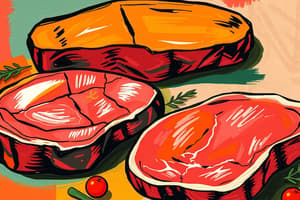Podcast
Questions and Answers
What is the average water content in beef as stated in the provided information?
What is the average water content in beef as stated in the provided information?
- 77.65% (correct)
- 80%
- 78%
- 75%
Which factor is mentioned as influencing the quality of meat and carcass before slaughter?
Which factor is mentioned as influencing the quality of meat and carcass before slaughter?
- Nutrition of the animal (correct)
- Age of the animal
- Physical properties of the meat
- Storage conditions
What is one of the stated goals of the research mentioned?
What is one of the stated goals of the research mentioned?
- To compare domestic and imported beef
- To increase beef production in Indonesia
- To enhance beef import regulations
- To provide information on physical quality of beef (correct)
What is indicated as lacking in the study regarding beef quality?
What is indicated as lacking in the study regarding beef quality?
According to the information provided, what are the major constituents of beef?
According to the information provided, what are the major constituents of beef?
What percentage of protein is present in beef according to the sources referenced?
What percentage of protein is present in beef according to the sources referenced?
Which of the following places is mentioned as a source of beef in Ambon?
Which of the following places is mentioned as a source of beef in Ambon?
What characteristic is associated with quality beef according to the research?
What characteristic is associated with quality beef according to the research?
What was the main focus of the research conducted in Ambon City traditional market?
What was the main focus of the research conducted in Ambon City traditional market?
Which method was used for the research on beef quality?
Which method was used for the research on beef quality?
What was the range of water content found in the beef samples?
What was the range of water content found in the beef samples?
What was the range of pH levels found in the beef during the study?
What was the range of pH levels found in the beef during the study?
What does WHC stand for in the context of this beef quality research?
What does WHC stand for in the context of this beef quality research?
What was the range of cooking loss percentages found in the beef samples?
What was the range of cooking loss percentages found in the beef samples?
What percentage of protein is expected to come from animal sources in Indonesia, according to the data provided?
What percentage of protein is expected to come from animal sources in Indonesia, according to the data provided?
How much beef was sampled from the sellers in the Ambon City traditional market?
How much beef was sampled from the sellers in the Ambon City traditional market?
What is the normal pH range of beef as stated in the content?
What is the normal pH range of beef as stated in the content?
How does a decrease in pH affect the growth of bacteria in meat?
How does a decrease in pH affect the growth of bacteria in meat?
What effect does high moisture content in beef have on microbiological growth?
What effect does high moisture content in beef have on microbiological growth?
Which of the following statements is true regarding the water content in beef?
Which of the following statements is true regarding the water content in beef?
What happens to the pH of meat during the glycolysis process?
What happens to the pH of meat during the glycolysis process?
Which of the following contributes to increased water content in meat over time?
Which of the following contributes to increased water content in meat over time?
What is one effect of water content in meat?
What is one effect of water content in meat?
According to the content, what is the average water content of beef reported?
According to the content, what is the average water content of beef reported?
What is indicated by a high pH level in meat?
What is indicated by a high pH level in meat?
What is the purpose of measuring the pH of meat before consumption?
What is the purpose of measuring the pH of meat before consumption?
How is Cooking Loss measured in the study?
How is Cooking Loss measured in the study?
Which method is used to prepare the meat sample for pH measurement?
Which method is used to prepare the meat sample for pH measurement?
What equipment is necessary for conducting the pH measurement?
What equipment is necessary for conducting the pH measurement?
During the study, how many times were the pH measurements repeated?
During the study, how many times were the pH measurements repeated?
Why is it important to conduct physical quality tests on meat?
Why is it important to conduct physical quality tests on meat?
What indicator is used to detect the decline in meat quality?
What indicator is used to detect the decline in meat quality?
What is the highest value of water holding capacity (WHC) reported in the study?
What is the highest value of water holding capacity (WHC) reported in the study?
How does the age of the cattle affect cooking loss?
How does the age of the cattle affect cooking loss?
What is the range of cooking loss values for beef reported in the findings?
What is the range of cooking loss values for beef reported in the findings?
What factor is mentioned as influencing cooking loss in beef?
What factor is mentioned as influencing cooking loss in beef?
According to the study, what is the normal range for water holding capacity (WHC) in beef?
According to the study, what is the normal range for water holding capacity (WHC) in beef?
Study Notes
Physical Quality of Beef in Traditional Markets
- Increased meat demand in Indonesia correlates with rising population, leading to higher consumption of animal protein.
- Beef is a significant source of protein, aiming to ensure quality for safe consumption.
- In 2020, beef consumption was approximately 2.31 kg per capita, around 628,000 tons, with projections suggesting further increases in 2021.
Research Methodology
- Study conducted in Ambon City over two months, sampling 1 kg of fresh beef from six different sellers in traditional markets.
- Key evaluations included moisture content, pH levels, cooking loss, and water holding capacity (WHC) using a completely randomized design (CRD).
Water Content and pH Levels
- Water content ranged from 74.83% to 76.04%, within acceptable norms.
- Standard pH levels were between 5.47 and 5.87, indicative of normal conditions that inhibit bacterial growth.
Cooking Loss and Water Holding Capacity (WHC)
- Cooking loss figures varied from 26.84% to 38.51%, influenced by muscle fiber structure and age of the cattle.
- WHC values were measured between 28.98% and 37.15%, aligning with normal ranges of 20% to 60%.
Implications of the Findings
- High water content in beef contributes to microbial growth, posing risks to meat quality over time.
- Cooking loss is an indicator of the meat’s ability to retain moisture during cooking, affecting texture and flavor.
Nutritional Context
- Beef provides roughly 18.26% protein and is essential in enhancing nutritional value in the population.
- With a rising need for animal protein, understanding beef quality aids consumers in making informed purchasing decisions.
Conclusion
- The study emphasizes the importance of physical quality testing in ensuring the meat's safety and suitability for consumption in traditional markets.
Studying That Suits You
Use AI to generate personalized quizzes and flashcards to suit your learning preferences.
Description
This quiz explores the physical quality of beef in traditional markets, focusing on factors such as moisture content, pH levels, and cooking loss. Based on a study conducted in Ambon City, the quiz covers important metrics for ensuring safe consumption of beef. Test your knowledge on beef quality parameters and their implications for consumer safety.




